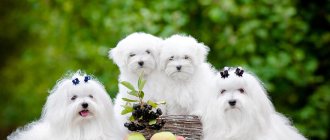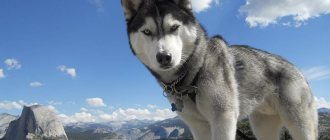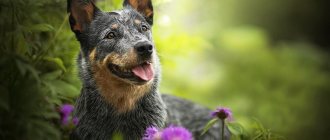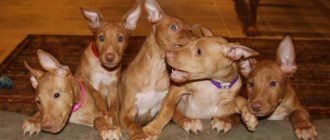History of the breed
This breed got its name thanks to the Portuguese, who settled in the Azores from the beginning of the 15th century. When sailing to the islands, they brought with them Fila Traceira, Bulldog, Great Dane and Mastiff dogs to guard their homes; as a result of crossing these breeds and local aboriginal dogs, Azorean dogs were obtained.
The Portuguese noticed that the resulting breed of dogs was distinguished by good endurance, hard work and loyalty to the owner, so they began to use these dogs as assistants while herding cattle. The isolation of the islands led to the fact that the Sanmigueli were preserved in their original form and were bred without the admixture of other breeds.
In the nineteenth century, representatives of this breed began to penetrate into mainland Portugal, where they quickly became a popular breed; some of the breed were even exported to Brazil, Mozambique and Angola. However, real popularity came to the breed only from the beginning of the 20th century, and from the late 70s. these dogs began to actively participate in international dog competitions.
In 1984, the first breed standard was adopted for the Cau Fila de San Miguel, and eleven years later the breed was recognized by the Fédération Cynologique Internationale.
How did herding dogs appear?
It is generally accepted that herding dogs appeared long ago among nomadic Asian tribes.
Their large and brave animals could easily drive away a bear, a wolf, or a stranger from the owner’s herd. Improving the skills and abilities of such dogs began in Europe. The inhabitants of this continent believed that significant size and boundless courage are not a complete list of qualities that shaggy shepherds need. These dogs must be different in color from predators in order to be noticeable at night and not act as a target for the owner’s gun. To obtain this color, Europeans began to crossbreed their dogs with local dogs, as a result of which the desired results were obtained.
Also, a significant contribution to the development of this group of breeds was made by the Roman people, who wanted to adapt the animals to fight various predators. This section presents herding dog breeds with photographs and names, which makes it possible to get a general idea of these animals.
Since ancient times, people have domesticated sheep, goats, and then cattle. At the same time, a person’s constant companion in the pasture is a dog. This magnificent comrade not only assisted in grazing the herd, but also protected it from attacks by predators. Initially, all representatives of this group were called shepherds, and only centuries later were herding breeds identified. Each breed of herding dog has its own positive qualities and characteristics.
Exterior
"Sanmigueli" are large dogs with a fighting build. With its terrifying appearance it is a bit reminiscent of a hyena. The height at the withers of males is 50 - 60 cm , for females 47 -58 cm , weight respectively 26 -47 kg , and 21 -33 kg .
Dogs have a large head, with a clear transition from the forehead to the muzzle. The nose is large and wide, black in color. The jaws are powerful with a full set of teeth (42 pcs.). The eyes are not large, oval in shape, color from light orange to dark chestnut. The look is very lively and expressive. Triangular-shaped ears are usually cropped in childhood.
The neck is of medium length, muscular with a scruff. The body is powerful with a wide chest. The croup is short, slightly higher than the withers. Forelegs and hindlimbs are straight with well-developed muscles. The paws are oval shaped and the toes are slightly curved. The tail is set high, tapers to the tip, and can be docked in childhood.
The Azorean dog's coat is short and smooth, with an undercoat. The color can be quite varied: different shades of yellow, gray, dark gray, fawn. The pattern can be either brindle or grainy, and there may be white spots on the limbs and forehead.
Samoyed dog
The Samoyed was developed in Siberia from indigenous breeds. There is a version that the northern peoples (Nenets, Samoyeds) domesticated the northern wolf. The dog is very similar to this predator. She has powerful teeth and a correct bite. The head is wedge-shaped, the nose is black, the eyes are dark brown. The dog is of medium height with a muscular body and strong legs, has its own charm, similar to a small polar bear.
Color white or beige. When the Nenets harnessed the dogs to the sleigh, and they drove through the white snow, it seemed as if the sleigh was moving itself. Hence one of the versions of the name. The coat is thick (it becomes even thicker in the cold), straight and hard, the undercoat is soft. It is self-cleaning, so the Samoyed is washed 2-3 times a year. Does not have a distinct dog smell.
Previously, the dog was used to guard herds of domesticated reindeer.
She has a soft, friendly, cheerful character and gets along well with children. Alert with strangers, but friendly. Sometimes she can be capricious and disobedient.
A dog needs dynamic, daily physical activity, so it is not recommended for busy people to get one.
| Breed | Type | Weight | Height | Color | Lifespan |
| Samoyed | Watchman, riding | 15 – 30 kg | 50 – 58 cm | White, cream | 12 – 15 years |
Character
Fila Saint Miguel combines well the qualities of guard and herding dogs . They quickly get used to their family and clearly divide everyone into “friends” and “strangers,” and this applies not only to people, but also to other pets. The Azorean dog shows the warmest feelings towards its family and will be endlessly devoted, but towards strangers it will be wary and even aggressive.
It is difficult for Azorean dogs to endure a change of owner and place of residence, since these dogs are monogamous. These dogs tend to be dominant, so they need early socialization and an experienced owner.
“Sanmigels” are distinguished by high intelligence; they can clearly distinguish an imaginary danger from a real one and independently make a decision in a difficult situation.
The Sanmiguel Fila gets along well with other dogs and other pets; problems can only arise between dogs of the same sex of the same breed. They treat children well, but do not like loud noise, and will not take part in children's pranks; they will not make nanny dogs.
Samoyed dog
The Samoyed dog is a friendly, loyal animal that combines the best traits of an active companion and a playful pet.
Characteristic:
- Breed name: Samoyed dog;
- Country of origin: Siberia and northern Russia;
- Time of birth of the breed: XI century BC. e.;
- Type: companion dog;
- Weight: 15-30 kg;
- Height (height at withers): 50-55 cm;
- Lifespan: 12-15 years;
- Hypoallergenic: Yes.
The Samoyed is a primitive breed. This means that there was virtually no human intervention in selection, which is why the dogs are in enviable health. The Arctic Spitz is an animal accustomed to living in a pack and obeying its laws. This must be taken into account when building a relationship with your pet.
The Samoyed dog is distinguished by its flexible character, mobility, courage, and friendly attitude towards people and other animals. Samoyeds do not tolerate loneliness well. This breed is not suitable for use as a yard dog or chain dog.
Training and care
The freedom-loving nature of the Azorean Shepherd Dog does not allow it to be kept in an apartment; it needs fresh air and great physical activity.
Raising an Azorean dog must be done with a “ steady hand ”; a novice breeder cannot cope with it. It is impossible to punish these dogs, but it is necessary to show persistence and steadfastness. If a common language has been found, training will proceed quickly, since these dogs are very smart and always want to please their owner. These dogs must be constantly working, as they do not tolerate inactivity. With proper training, the Sanmiguel Fila can also become a wonderful assistant for hunting bear and wild boar.
Caring for an Azorean Cattle Dog is not much of a hassle. The coat should be combed once a week with a rubber glove, and bathed only if the dog is very dirty. Regularly you need to clean your dog's ears, wipe his eyes with boiled water and trim his nails.
These dogs do not tolerate low temperatures well, so in winter the dog cannot be left in the enclosure, it must be taken into the house.
Welsh Corgi
This is a Welsh shepherd dog breed. A characteristic feature of the breed is a long, wide, strong body and short legs. The height at the withers of adult individuals reaches 30 cm, and weight up to 15 kg. Corgis are distinguished by their great love of life, devotion, and goodwill. Cheerful in nature, the Corgi loves long walks in the fresh air. Very trainable, remembers commands literally the third time
Hunting and guarding instincts are developed at a high level - therefore this dog is often used to guard small herds.
Corgi loves to eat, so it is important to monitor her food intake and prevent overeating. Training and daily long walks are essential elements in caring for these dogs.
Nutrition
The Azores shepherd dog can be fed with both high-quality dry food and natural products; in the latter case, the dog must additionally be given complexes of vitamins and microelements. If the dog eats natural products, then the diet should look something like this:
- Meat (low-fat varieties), offal -50%
- Porridge (oatmeal, wheat, barley) – 15%
- Dairy products – 15%
- Vegetables and fruits - 10%
- Eggs.
You cannot feed table scraps, since any spices and salt are contraindicated for the dog. Also, the diet should not contain sweets, baked goods and smoked products.
Bobtail
The shaggy English Bobtail is a friend to sheep and a threat to wolves. Many times he emerged victorious from a fight with a gray predator. In ordinary life, bobtails are not aggressive and have become favorite pets of many families. Their shepherd service is a thing of the distant past, but they have not lost their instinct and are ready to look after all family members around the clock. “Shaggy nannies” have a special affection for children and will never offend them. The breed is rare, the price of a puppy reaches $3000. Nurseries are located in Moscow, St. Petersburg, Smolensk, Yekaterinburg. Bobtail is a screen star, he is often featured in food commercials, and the films “The Taming of the Shrew” and “Cats and Dogs” were filmed with his participation.
In fact, there are many more herding dogs in the world. Almost every corner of the globe where there is a need to herd herds has its own breed. France, Germany, Portugal, Romania, Czechoslovakia, Italy, Belgium, Ireland - they all boast their own “shepherds”. In Australia and Scotland alone there are about five varieties. They all have one quality in common - they are incredibly devoted to people.
- Dogs that look like foxes
- The largest dogs: breeds
- TOP 10 dog breeds for children
Health
Representatives of this breed are considered healthy dogs, and no genetic diseases have been identified in them. However, if the dog is not properly cared for, the dog may develop hip and elbow dysplasia. A mandatory condition for keeping dogs is timely vaccination against all infectious diseases of dogs.
Cau Fila de San Miguel is prone to obesity, so it is very important that she does not overeat. With proper care, such dogs can live up to 15 years .
Sheepdog from Portugal
The Portuguese Shepherd has long been valued for its herding qualities. The manner of her behavior is to drive cattle by barking, and also by silently walking around a flock or herd when grazing them. This is a medium-sized dog (42-55 cm, 12-18 kg) with thick, long and slightly coarse hair. There is no undercoat. Modern representatives of the breed are predominantly black in color, but there are also individuals of gray, reddish, yellow and brown color. As you can guess from the name, the native breed is Portugal, or more precisely its regions of Alentejo and Ribatero. Experts assume a close relationship with such breeds as the Briard, Pyrenean and Catalan Shepherd. Excellent watchdog qualities, tolerance to various weather conditions and unpretentiousness in food, as well as energy, vigilance, and at the same time calmness and balance - all these qualities are inherent in Portuguese Shepherds.
Breed photo
Links
| Herding dog breeds | |
| Breeds for grazing and driving livestock | Australian Short-tailed Cattle Dog · Australian Shepherd · Australian Cattle Dog · Australian Kelpie · English Shepherd · Appenzeller Mountain Dog · Basque Shepherd · White Swiss Shepherd · Belgian Shepherd (Groenendael, Laekenois, Malinois, Tervuren) · Bergamasco Sheepdog · Bernese Mountain Dog · Blue Lacy · Bobtail · Greater Swiss Mountain Dog · Border Collie · Beauceron · Briard · Catahoula Bulldog · Cardigan Welsh Corgi · Pembroke Welsh Corgi · Gamper · Dutch Shepherd · Icelandic Dog · Spanish Water Dog · Catalan Shepherd · Bearded Collie · Longhaired Collie · Can de Palleiro · Shorthaired Collie · Coolie · Lancashire Heeler · Lapp Deer Dog · Catahoula Leopard Dog · Mallorcan Shepherd · Miniature Australian Shepherd · Mudi · German Shepherd · New Zealand Shepherd · Picardy Shepherd · Pyrenean Shepherd · Polish Lowland Shepherd · Portuguese Shepherd · Poo Lee · Pumi · Sanmiguel Shepherd · Tibetan Terrier · Tornjak · Welsh Sheepdog · Bouvier des Flandres · Canaan Dog · Croatian Shepherd · Swedish Vallhund · Shetland Sheepdog · Entlebucher Mountain Dog |
| Breeds for livestock guarding | Akbash · Anatolian Shepherd Dog · Bukovinian Shepherd Dog · Gampr · Spanish Mastiff · Caucasian Shepherd Dog · Cao de Castro Laboreiro · Karakachan Dog · Komondor · Crash Shepherd Dog · Kuvasz · Leonberger · Maremmo-Abruzzese Shepherd Dog · Mahorero · Pyrenean Mountain Dog · Pyrenean Mastiff · Polish Podgalian Shepherd Dog · Portuguese Watchdog · Romanian Carpathian Shepherd Dog · Romanian Mioritic Shepherd Dog · Slovakian Dude · Central Asian Shepherd Dog · Tibetan Mastiff · Tibetan Terrier · Sharplana Shepherd Dog · Estrela Shepherd Dog · South Russian Shepherd Dog |
Mating
Mating must be taken very seriously in order to get healthy offspring:
- Before the procedure, be examined by a veterinarian and take genetic tests. Unfortunately, if the dog is a carrier and especially a carrier of a disease that will affect the offspring, mating is prohibited. Various crossing options are considered when there is a high probability of the birth of healthy puppies. The breeders are responsible in each case.
- Heelers that have reached 1.5 years of age are considered sexually mature. Bitches go into heat in the autumn and spring. It is customary for owners to breed a pair on the 2nd or 3rd heat and 8–10 days after the start.
- Mating takes place traditionally in the territory of the male. If the male does not recognize the female and shows aggression, the procedure is repeated every other day. The best time of day for mating is morning.
- After proper mating and three months of gestation, puppies appear. The quantitative component of the litter is 1 – 7 pieces.
Notes
- [www.fci.be/uploaded_files/340gb2007_en.doc breed standard, history] (English)
- [www.vagabond-bg.com/?page=fun&sub=7&open_news=1079 Dogged by Dog Fights, by Katherine Watt, Vagabond, English language Bulgarian magazine. “Ear cropping is another fighting-dog feature”] (English)
- [web.archive.org/web/20091027032237/geocities.com/Heartland/Plains/7556/ Description of the Portuguese Breed Club] and [www.moloss.com/001/breed/c/c009/ Cão de Fila de São Miguel, WorldMolossov ] (English)
- com/molossoid_dog_breeds/cao_fila_de_sao_miguel_dog.html Dogs in Depth (English)
- Dog Breeds, Dan Rice, DVM pg 51, Barron's Educational Series, March 1, 2001, ISBN 0-7641-1649-5 (English)
- [www.canismajor.com/dog/bloat.html Deep-chested dogs are susceptible to gastric torsion] (English)











